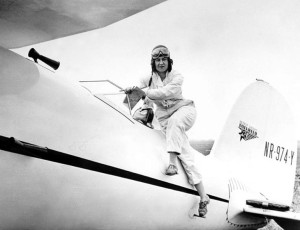Originally published on the FAA’s internal website and at Medium
By K. Daniel Glover

Thomas Selfridge (left) with Alexander Graham Bell, who recruited the military aviator for his Aerial Experiment Association that was competing with the Wright Brothers to be the first in flight (Photo: Air National Guard)
The tragedy occurred at a key point in aviation history, as the U.S. Army considered a contract to buy airplanes from the Wright brothers. Orville Wright was at the controls of the Wright Flyer that day, nearly five years after he and his brother, Wilbur, made history with flights at Kitty Hawk, N.C. Selfridge, an Army lieutenant with an aviation background, was his passenger — a concession that Orville Wright made reluctantly to try to win the contract.
The two were in the air above Fort Myer, Va., for just a few minutes when a propeller malfunction triggered a chain of events that sent the aircraft plummeting to the ground. Wright survived the accident with severe injuries, but Selfridge never recovered from a fractured skull.
A storied history of Selfridge success
The Selfridge surname was well established in military circles before Thomas Etholen Selfridge was born in 1882. His grandfather and uncle, who shared the name Thomas O., had distinguished Navy careers. Both rose to the rank of rear admiral, and the uncle led an expedition related to the Panama Canal.
Thomas E. Selfridge’s brother, Edward, also was part of an important event in U.S. history. He was part of an infantry regiment that supported future President Theodore Roosevelt’s Rough Riders at San Juan Hill in the Spanish-American War. “They were a pretty prominent family,” said Dan Heaton, who wrote a book about Thomas E. Selfridge while serving at the Air National Guard base in Michigan that bears the family name.

Selfridge (Photo: Air National Guard)
A native of San Francisco, Selfridge headed back home for his first assignment. He was at the Presidio during the 7.8-magnitude earthquake that devastated the City by the Bay in 1906, a tragedy that prompted a declaration of martial law. As a young lieutenant, he did such a remarkable job during search-and-rescue and cleanup operations that the Army gave him the choice of his next assignment. He opted to teach at West Point for a year and think about it.
While Selfridge was at the academy, Heaton said he wrote a letter to ask the Wright brothers if he could help in their workshop. But they didn’t want someone from the federal government watching them work on an innovative machine the government might want to buy.
Rebuffed by the Wright Brothers, Selfridge instead went to work for Alexander Graham Bell, who turned his attention to aviation and other interests after inventing the telephone. At Bell’s request, President Roosevelt assigned Selfridge to the Aeronautical Division of the U.S. Signal Corps in 1907. The corps assigned him to the Bell-funded Aerial Experiment Association for a year of research into an aircraft meant to compete with the Wright brothers’ work. Selfridge eventually piloted — and crashed into the water — an unpowered, tetrahedral kite called Cygnet.
(more…)


